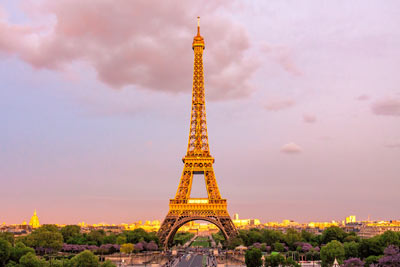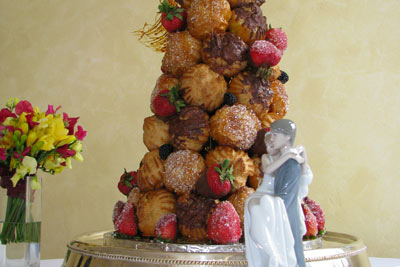French Wedding Traditions
FrenchWedding Traditions
FrenchWedding Traditions
Traditions
 French traditions have influenced many of the customs commonly observed in American weddings, while others are uniquely French. We have included many traditions from France, and certain traditions in the United States. Please feel free to contact us with your comments, and any other traditions which you would like us to include. Enjoy!
French traditions have influenced many of the customs commonly observed in American weddings, while others are uniquely French. We have included many traditions from France, and certain traditions in the United States. Please feel free to contact us with your comments, and any other traditions which you would like us to include. Enjoy!
The “wedding armoire” or hope chest, hand-carved with symbols of wealth and prosperity, is used for the bride’s trousseau. A ritual bath is a widespread custom in many European countries, especially in France. The custom symbolizes the purification of the bride of all evil influences – and thoughts of previous boyfriends – from earlier in her life.
Everything is white: flowers, dresses and decorations.
On the wedding day, the groom may meet the bride at her house and proceed with her to the processional of guests, who walk to the church. It is traditional for children to block the path with white ribbons, which the bride must cut.
In a church filled with incense and flowers, the couple stands beneath a silk canopy. A predecessor of the veil was termed “carre’,” which were held over the head of the bride and bridegroom in French weddings as the couple received the priest’s final blessing. They were designed to protect the couple from evil influences.
Outside the church, laurel leaves are laid down as a bridal path.
In some parts of France help-seed or wheat is showered over the couple, or the bride is received with three loaves of bread.
Reception tables overflow with flowers guests bring to honor the couple’s fresh beginning. Brides wear wreaths of flowers in their hair. The bride often wore a special hat for the same reason.
The bride and bridegroom toast each other from an engraved, two-handled cup (the coup de mariage), which is passed on to future generations.
Chiverie is the wedding night prank of clanging pots to interrupt the nuptial couple; the groom must invite the mischief makers in for refreshments. This mock serenade used to be played at all weddings. Sometimes, however, only unpopular weddings were subjected to it.
The French brought the custom to America, where it spread from Canada and Louisiana to the South and Midwest. In rough pioneer settlements, the “shivaree“, as it came to be called, was very popular and often elaborated into a ritual humiliation of the bride and bridegroom. This has led to tying a cowbell under the bed or tying cans to the car, still scaring away spirits.
The All-White Wedding Quilt: In the 18th century Provencal tradition was to make, or have made, a white wedding quilt to rest on top of the marriage bed. This tradition resulted in lavishly stitched and stuffed confections filled with symbols of love, femininity, fidelity, fertility, and prosperity.
Food & Music
In Brittany, the wedding party and the bride and groom drink from a glass of brandy poured over a piece of white bread, symbolic of the beginning of the “toasting” custom. The couple has the last sip and eats the bread for good luck.
Planning
Coming Soon
Checklists
Coming Soon
Tips
Coming Soon
Dresses
Coming Soon
Cakes
 Today’s wedding cakes are in adaptation of French pastry to English customs. Originally, large, thin biscuits were broken over the head of an English bride. By Elizabethan times, these biscuits had changed into small, square cakes. The French influence added icing. Long ago in France, it was the custom for villagers to throw buns into a pile in preparation for the wedding feast. A clever baker decided to take some bun-like pastries stuffed with cream and fastened them as a pyramid, like the mound of buns, creating a tall cone of caramel-coated cream puffs called croque-en-bouche (“crisp in the mouth”). The cone may be topped with caged doves, which are released to symbolize the newlyweds’ departure from their families.
Today’s wedding cakes are in adaptation of French pastry to English customs. Originally, large, thin biscuits were broken over the head of an English bride. By Elizabethan times, these biscuits had changed into small, square cakes. The French influence added icing. Long ago in France, it was the custom for villagers to throw buns into a pile in preparation for the wedding feast. A clever baker decided to take some bun-like pastries stuffed with cream and fastened them as a pyramid, like the mound of buns, creating a tall cone of caramel-coated cream puffs called croque-en-bouche (“crisp in the mouth”). The cone may be topped with caged doves, which are released to symbolize the newlyweds’ departure from their families.
Resources and References
Special thanks to Lois Pearce, Master Bridal Consultant of Hamden, Connecticut, for her time and energy gathering the majority of information used here. We also wish to thank the Association of Bridal Consultants for their assistance.
Please note that the information contained in this category should be considered general in nature. We believe it to be a true and accurate representation of some of the customs and traditions for this country or religion. Information provided by individuals and organizations is assumed to be correct. You are welcome to email us at join@weddingdetails.com with any suggestions for changes, additions or deletions.
